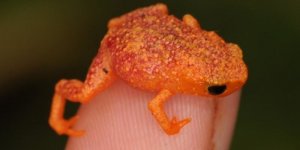| News / Science News |
Unexpected Discovery Under Greenland Ice
An international team of researchers has discovered a large meteorite impact crater hiding beneath more than a half-mile of ice in northwest Greenland. The crater — the first of any size found under the Greenland ice sheet — is one of the 25 largest impact craters on Earth, measuring roughly 1,000 feet deep and more than 19 miles in diameter.

Radar data from an intensive aerial survey of the Hiawatha crater in May 2016 is shown here in aqua-colored curtains. A blue arrow points to the central peak of the crater. Credits: NASA/Cindy Starr
The group, led by researchers from the University of Copenhagen’s Centre for GeoGenetics at the Natural History Museum of Denmark worked for the past three years to verify their discovery, which they initially made in 2015 using NASA data.
The researchers first spotted the crater in July 2015. The scientists noticed an enormous, previously unexamined circular depression under Hiawatha Glacier, sitting at the very edge of the ice sheet in northwestern Greenland.
To confirm their suspicions, in May 2016 the team sent a research plane from Germany’s Alfred Wegener Institute to fly over the Hiawatha Glacier and map the crater and the overlying ice with a state-of-the-art ice-penetrating radar provided by the University of Kansas.
The survey exceeded all expectations and imaged the depression in stunning detail: a distinctly circular rim, central uplift, disturbed and undisturbed ice layering, and basal debris.
The crater formed less than 3 million years ago, according to the study, when an iron meteorite more than half a mile wide smashed into northwest Greenland. The resulting depression was subsequently covered by ice.
The crater’s condition indicates the impact might even have occurred toward the end of the last ice age, which would place the resulting crater among the youngest on the planet.
In the summers of 2016 and 2017, the research team returned to the Hiawatha Glacier to map tectonic structures in the rock near the foot of the glacier and collect samples of sediments washed out from the depression through a meltwater channel.
"Some of the quartz sand coming from the crater had planar deformation features indicative of a violent impact; this is conclusive evidence that the depression beneath the Hiawatha Glacier is a meteorite crater," said associate professor Nicolaj Larsen of Aarhus University in Denmark, one of the authors of the study..
Earlier studies have shown large impacts can profoundly affect Earth’s climate, with major consequences for life on Earth at the time. The researchers plan to continue their work in this area, addressing remaining questions on when and how the meteorite impact at Hiawatha Glacier affected the planet. (NASA)
YOU MAY ALSO LIKE


